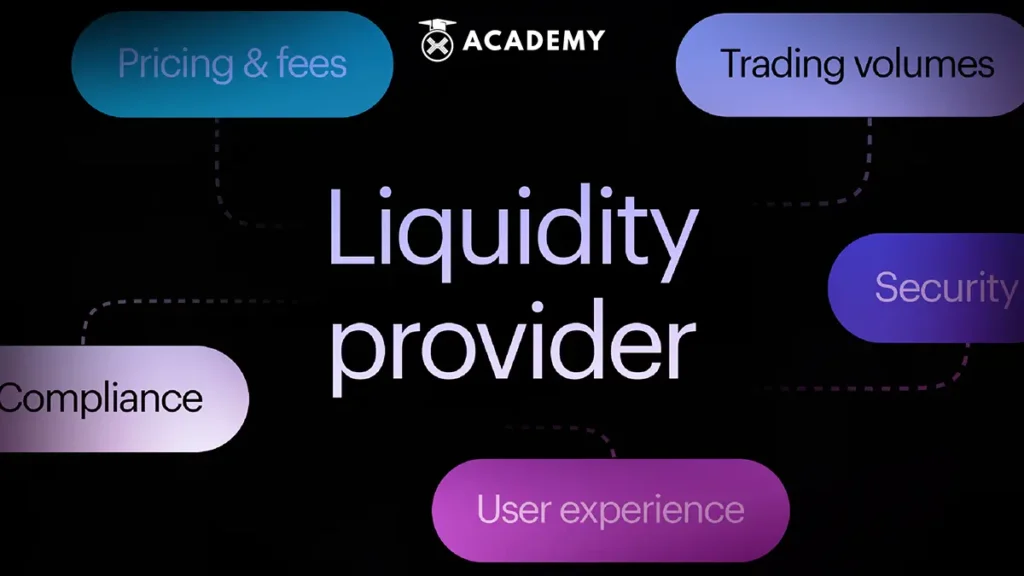Every market has dynamics between buyers and sellers, significantly impacting market conditions through their influence on supply and demand. This concept of the roles of buyers and sellers is also relevant in the context of financial instruments. The existence of buyers and sellers creates a level of liquidity in the financial instrument. The impact of this interaction creates convenience for individuals to make purchases and sales because there is a smooth flow of supply and demand.
To manage this smoothly, parties are called liquidity providers (LP). This liquidity provider is responsible for regulating the flow of demand and supply and ensuring that the market can operate efficiently and market participants can easily carry out transactions.
So, to understand what a liquidity provider is, from its role and types, its meaning in the crypto world, how the token works, its advantages and disadvantages, to the difference with a market maker, see the complete review below!
What is A Liquidity Provider, and What are Its Roles & Types?
A liquidity provider is a liquidity provider for certain financial instruments. The way liquidity providers work includes buying and selling activities of these instruments based on demand and supply taking place in the market.
The main aim of a liquidity provider is to maintain the liquidity of related instruments so that it remains optimal. Parties acting as liquidity providers include institutional investors, such as banks, securities companies, and other entities. However, it should be noted that a retail investor can act as a liquidity provider if he acts as a market maker or sells the securities he owns. The reason is that by selling securities, retail investors can facilitate the purchase of securities by other parties, which then maintains the liquidity of transactions in these securities. Therefore, it is not surprising that many trading platforms set securities selling fees that are lower than purchasing fees.
The liquidity provider’s role is to maintain an instrument’s liquidity level in the market. Maintaining this level of liquidity is important for the following reasons:
- A high level of liquidity in an instrument indicates that the instrument is in demand by many traders and investors.
- Due to the large participation of investors and traders in these instruments, the prices of these instruments tend to be stable, providing security, especially for novice investors or traders;
- On the other hand, instruments without a stable level of liquidity may experience sharp price fluctuations, making them less attractive to the general public;
- As a liquidity provider, they can buy and sell the same instrument at any given time, regardless of the profit or loss resulting from the transaction. The liquidity provider business model is different from that of traders or investors.
Even though liquidity providers are generally institutional investors with large capital who have the potential to influence market prices, it is still important for traders and retail investors to anticipate every transaction they make.
Definition of Liquidity Provider in the Crypto World

Quoting techopedia.com, a liquidity provider, provides buy and sell orders to decentralized finance (DeFi) projects to increase market liquidity. They do this by depositing crypto assets into a pool that can be used by other traders to make exchanges on the platform.
This liquidity provider plays an important role in trading crypto assets in DeFi. They are a source of trading volume that ensures that trades can be executed as planned and at the prices desired by the parties to the transaction. Liquidity providers can be market makers, high-frequency trading companies, investment banks, financial institutions, or individual users. In general, liquidity providers have many assets on the exchange, allowing them to provide instant buy and sell orders to meet trader requests.
How Token Liquidity Providers Work
Quoting coinmarketcap.com, a liquidity provider on a decentralized exchange (DEX) that operates on the Automated Market Maker (AMM) protocol. Uniswap, Sushi, and PancakeSwap are examples of popular DEXs that distribute liquidity provider tokens to their liquidity providers.
Liquidity provider (LP) tokens track individual contributions to the overall liquidity pool. This is because the liquidity provider (LP) tokens owned correspond proportionally to the liquidity share in the overall pool. At a basic level, liquidity provider (LP) tokens work based on the following formula:
Total Liquidity Pool Value / Circulating LP Token Supply = Value of 1 LP Token
Regarding technical properties, liquidity provider tokens are not too different from other tokens on the same network. For example, the liquidity provider tokens issued by Uniswap and Sushiswap, which operate on the Ethereum network, are ERC20 tokens. Like other ERC20 tokens, this liquidity provider token can be transferred, traded, and staked on other protocols.
Like other tokens, having a liquidity provider token gives the liquidity provider full control over the locked liquidity. Most liquidity pools allow providers to redeem their provider liquidity tokens at any time without interference, although many may charge a small penalty if you redeem them too quickly.
The relationship between a liquidity provider’s token and a proportional share of the liquidity pool is most commonly used in at least two of the following cases:
- To determine the liquidity provider’s share of transaction fees accumulated during liquidity provision;
- To determine how much liquidity is returned to the liquidity provider from the liquidity pool when the liquidity provider decides to redeem their liquidity provider tokens.
Furthermore, there are many other uses for liquidity provider tokens emerging on modern DeFi platforms, including:
- Staking liquidity provider tokens to earn further rewards is a way to encourage liquidity providers to lock their liquidity into the pool. Sometimes, this is referred to as “farming”.
- Using the value of the provider’s liquidity token as a qualifying factor for accessing an Initial DEX Offering (IDO), that is, to participate in certain IDOs, a person must have a certain value of the provider’s liquidity token.
What Are the Advantages and Disadvantages of Liquidity Providers?
There are several advantages and disadvantages of being a liquidity provider. Quoting techopedia.com, here are some advantages and disadvantages of liquidity providers that you need to know, namely:
Advantages of Liquidity Providers
- Earning Fees
The main advantage of becoming a liquidity provider is earning some of the fees generated by DeFi projects. This usually encourages liquidity providers to maintain liquidity and keep their funds locked in liquidity pools.
- Yield Farming and Staking
Liquidity providers can use various strategies to generate additional profits from their liquidity provider tokens. This strategy includes yield farming and staking, allowing liquidity providers to maximize returns and participate in the platform ecosystem.
- Additional Incentives
It is important to note some DeFi platforms provide additional incentives and governance rights to liquidity providers. These incentives may include a portion of platform revenue, voting rights in protocol decisions, or access to exclusive features.
Disadvantages of Liquidity Providers
- Impermanent Loss
One of the biggest risks of being a liquidity provider is temporary losses. It occurs when a change in token price causes a user’s share of the liquidity pool to be less than the value of their deposit. Liquidity pools with volatile crypto pairs are more susceptible to temporary losses. Users can choose crypto pairs with a smaller price range to reduce this risk.
- Hack and Exploitation Risks
Liquidity pools rely on smart contracts to operate. When liquidity providers deposit their funds into smart contracts, the security of their assets is tied to the strength and security of the smart contracts governing the network. As a result, failure or compromise of smart contracts can result in loss of funds.
- Missed Opportunities
Because liquidity providers need to lock their funds in a pool, they may miss out on potentially profitable opportunities in the crypto market.
Can Liquidity Providers Affect Financial Markets?

Please note liquidity providers have a big impact on financial markets. The following are some of the impacts of liquidity providers that need to be known, including:
1. Increase Liquidity
Liquidity providers are crucial in increasing financial market liquidity by providing certain financial assets for trading. The presence of a liquidity provider allows traders to easily buy and sell financial assets without having to wait for other parties who are willing to transact at the same price.
2. Minimize the Spread
Liquidity providers can reduce the spread or difference between buying and selling prices on certain financial assets. This reduces transaction costs for traders and strengthens the market’s attractiveness.
3. Maintain Price Stability
Liquid providers can maintain price stability for certain financial assets by offering adequate demand and supply. This is important to prevent excessive price fluctuations and reduce risks for traders.
4. Increase Market Efficiency
The presence of a liquidity provider allows traders to quickly find transaction partners, optimize market efficiency, and speed up the trading process.
5. Provide Liquidity Guarantees
Liquidity providers can provide liquidity guarantees for certain financial assets. This helps reduce liquidity risks for traders and reduces risks for financial institutions that hold those financial assets.
How Do Liquidity Providers Profit?
An exchange or an exchange has earned profits directly or indirectly through liquidity providers. Here are some ways in which exchanges generate profits that are worth knowing, including:
1. Asset Supplier
Since the liquidity provider has enough digital assets, the exchange will not experience a shortage of crypto supply. Most of the crypto on exchanges is supplied by liquidity providers to maintain the market.
2. Setting Market Prices
In addition to keeping the market stable, crypto liquidity providers help set market prices for exchange owners. Since investors have in-depth knowledge of the market’s functions, they will likely determine the perfect price for each cryptocurrency and help make profits.
3. Faster Trade Execution
The liquidity provider directly influences the trading matching engine and the speed at which a cryptocurrency is bought or sold between two users. Once the platform’s liquidity increases, users trade faster and help generate income for owners through commission fees, withdrawal fees, etc.
Difference between Liquidity Provider vs Market Maker
Liquidity providers and market makers are important in maintaining financial market liquidity. However, there are significant differences between the two. Here are some differences you need to know, including:
1. How it Works
Liquidity providers operate by buying and selling certain financial assets to provide liquidity to the market. On the other hand, market makers play a role in creating a market for certain financial assets by offering buying and selling prices.
2. Asset Availability
Liquidity providers generally only provide liquidity on certain financial assets. Meanwhile, market makers can create markets for various financial assets, including stocks, bonds, and forex.
3. Main Objective
The main goal of a liquidity provider is to provide liquidity to the financial market. On the other hand, market makers mainly generate profits by exploiting the difference between the buying and selling prices.
4. Risk
Liquidity providers tend to have lower risk due to their role as liquidity providers without involvement in market making. Market makers have greater risk because they have to maintain the difference between the buying and selling prices as a source of profit.
5. Scope of Operations
Liquidity providers generally operate in larger and more liquid financial markets, such as the forex and bond markets, while market makers can perform in smaller and less liquid markets.
Conclusion
In conclusion, liquidity providers have an important role in overcoming liquidity challenges in the crypto market. The existence of this liquidity provider is not only to maintain smooth transactions but also to play a big role in building a healthy crypto trading ecosystem. Liquidity providers are known to provide the necessary liquidity to facilitate trading, allowing market players to buy and sell crypto assets easily.
Liquid providers help reduce transaction costs and increase market efficiency by minimizing the difference between buying and selling prices. Furthermore, the importance of a liquidity provider is not limited to the practical aspects of trading but also to creating a stable and reliable environment for market players. By mitigating liquidity risk and providing certainty of transaction execution, ultimately, liquidity providers contribute greatly to the growth and development of the crypto market.
Invest in Crypto Assets on INDODAX with Staking (EARN) Feature
So, now you understand what a liquidity provider is, starting from its role and types, its meaning in the crypto world, how the token works, its advantages and disadvantages, and the difference between it and a market maker.
Next, if you are interested in investing in crypto assets, choosing a safe and trustworthy crypto exchange at INDODAX would be a good idea. Please note that at INDODAX, there is currently a feature called crypto staking or INDODAX Earn. This crypto staking feature allows you to secure crypto assets in a way that is similar to storing funds in a savings account. Crypto assets locked through the INDODAX Earn service will provide rewards like interest earned from a savings account.
It is important to note the INDODAX Earn crypto staking feature can be accessed easily anytime and anywhere via the mobile or desktop application on the INDODAX website.
Let’s start investing in crypto assets on INDODAX via the crypto staking feature right now!








